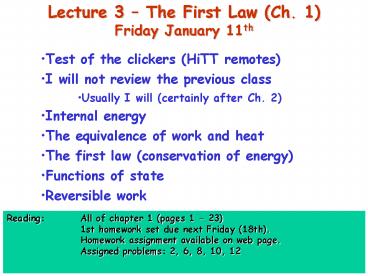Lecture 3 - PowerPoint PPT Presentation
1 / 12
Title:
Lecture 3
Description:
Joule's paddle wheel. experiment. Work = -DUgrav. W = -(-mgh) = mgh. Gravitational energy is lost. ... Joule's paddle wheel. experiment. Gravitational energy is lost. ... – PowerPoint PPT presentation
Number of Views:34
Avg rating:3.0/5.0
Title: Lecture 3
1
Lecture 3 The First Law (Ch. 1) Friday January
11th
- Test of the clickers (HiTT remotes)
- I will not review the previous class
- Usually I will (certainly after Ch. 2)
- Internal energy
- The equivalence of work and heat
- The first law (conservation of energy)
- Functions of state
- Reversible work
Reading All of chapter 1 (pages 1 - 23) 1st
homework set due next Friday (18th). Homework
assignment available on web page. Assigned
problems 2, 6, 8, 10, 12
2
Functions of state internal energy U
Adiabatic
Joules paddle wheel experiment
Work -DUgrav W -(-mgh) mgh
Measured as a change in temperature, q
Gravitational energy is lost. 1st law is about
conservation of energy. This energy goes into
thermal (internal) energy associated with the
fluid.
3
Functions of state internal energy U
Adiabatic
Joules paddle wheel experiment
DUfluid W mgh
Measured as a change in temperature, q
!!!!!!!!!!!!!!!!!!!!!!!
Gravitational energy is lost. 1st law is about
conservation of energy. This energy goes into
thermal (internal) energy associated with the
fluid.
4
Functions of state internal energy U
Stirring
Adiabatic
Rise in q (temperature)
DU W torque angular displacement t df
5
Functions of state internal energy U
Electrical work
Adiabatic
Rise in q (temperature)
R
i
DU W i 2R
6
Functions of state internal energy U
Reversible work
Adiabatic
Force, F
Rise in q (temperature)
DU W Force distance -P DV
7
Equivalence of work and heat
Heat, Q
Adiabatic
Same rise in q (temperature)
DU Q
8
The First Law of Thermodynamics
These ideas lead to the first law of
thermodynamics (a fundamental postulate)
DU Q W or dU dQ dW
The change in internal energy of a system is
equal to the heat supplied plus the work done on
the system. Energy is conserved if the heat is
taken into account.
Note that dQ and dW are not functions of state.
However, dU is, i.e. the correct combination of
dQ and dW which, by themselves are not functions
of state, lead to the differential internal
energy, dU, which is a function of state.
9
How to know if quantity is a function of state
U1
U2
10
How to know if quantity is a function of state
There is a mathematical basis.....
Consider the function F f(x,y)
11
How to know if quantity is a function of state
There is a mathematical basis.....
Consider the function F f(x,y)
12
How to know if quantity is a function of state
Differentials satisfying the following condition
are said to be exact
This condition also guarantees that any
integration of dF will not depend on the path of
integration, i.e. only the limits of integration
matter.































